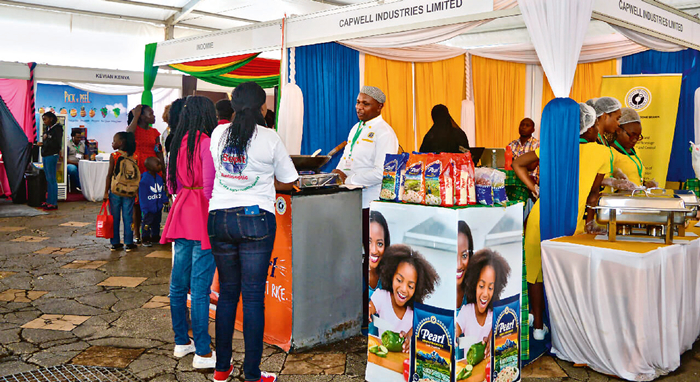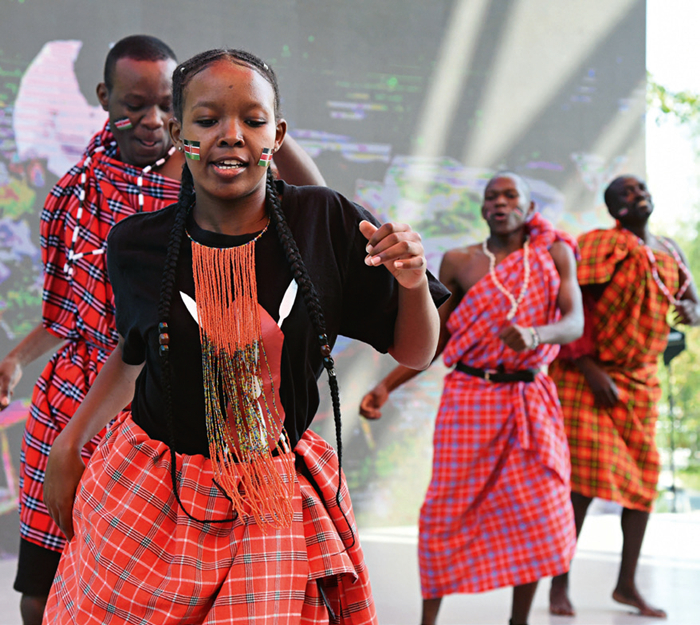|
||||||||||
| Home Nation World Business Opinion Lifestyle ChinAfrica Multimedia Columnists Documents Special Reports |
|
||||||||||
| Home Nation World Business Opinion Lifestyle ChinAfrica Multimedia Columnists Documents Special Reports |
| ChinAfrica |
| Buy Kenya - Build Kenya |
| Kenya aims to revitalize its garment sector |
| Reporting from Ethiopia Kiram Tadesse 丨VOL. 14 JUNE 2022 ·2022-06-09 |

Visitors talk to a local exhibitor at Changamka Kenya Shopping Festival held in Nairobi, Kenya, on April 4 to 7, 2019 (KENYA ASSOCIATION OF MANUFACTURERS)
Five years ago, Kenya introduced a strategy to build an export-oriented economy through diverse incentives and regimes. The Buy Kenya - Build Kenya strategy was designed to mitigate the impacts of the trade deficits, and inject and create momentum for sustained industrial and commercial growth in the East African country, among other benefits.
Subsequently, exports from the manufacturing sector have increased due to export incentives, says the Kenyan Government.
In May 2022, Kenya’s Industrialization, Trade and Enterprise Development Cabinet Secretary Betty Maina said that the country’s exports last year stood at more than 91 billion Kenyan Shilling ($784 million) while employment in the country’s export processing zones stood at about 65,000 people.
According to the East Africa Economic Outlook 2019 issued by African Development Bank (AfDB), in 2018, real GDP in East Africa was the highest among African regions by an estimated 5.7 percent. Its 2021 report indicates that East Africa’s GDP growth is projected to recover to an average of 4.1 percent in 2021 from 0.4 percent in 2020, supported by the global economic recovery.
Despite countries in the East African region like Ethiopia, Rwanda, Tanzania, Kenya, and Djibouti having registering high economic growth, the trade imbalance in these countries has remained one of the major economic challenges.
Similar exports conundrum
The AfDB reports show that domestic resource mobilization is a major challenge in East Africa, and that countries with tax revenues below 15 percent of GDP have difficulty in funding basic state functions.
Similarly, regardless of the positive trend in exports in these individual countries, according to the AfDB, the East African countries do not produce enough of what their neighbors want to import because they are all producers and exporters of primary commodities, and importers of manufactured goods. Due to this, the complementarity problem arises because of limited product differentiation in trade among these countries of the region.
Despite the great effort to produce and market primary products in global markets, there was a declining trend in the identity of Kenyan products abroad. Hence, the Buy Kenya - Build Kenya strategy found that development of local industries such as the textile sector has been greatly hampered by importation of cheaper products and a growing middle class with an appetite for imported products.
On the regional front, the recent relocation of Kenyan industries, due to relatively more conducive business incentives in neighboring countries, was also one of the weaknesses that are responsible for the low levels of productivity in Kenya.
Global competitiveness challenge
The Buy Kenya - Build Kenya strategy, therefore, saw the country’s potential to become a more competitive player in the regional and global economy through certain contributing factors. However, the Kenyan Government recognizes that the country’s global competitiveness remains challenged, due to low levels of productivity, an unconducive business regulatory environment and inadequate infrastructure development, in the face of rising importation of consumer products.
The strategy aims to promote competitiveness of domestically made products in both the domestic and international markets. There is also optimism that its effective implementation will go a long way in enhancing Kenya’s competitiveness and consumption of locally produced goods and services.
Cognizant of this scenario, Kenya’s cotton industry has been facing serious challenge for decades, as prices for the crop slumped in the face of a market that flooded with secondhand clothes. Thus, textile companies such as Raymonds, Kicomi, UTI, Bhupco, Mombasa Towels and TSS were all closed due to unfair competition from external companies, which led to a massive layoff of thousands of workers.
However, recent reports claim that demand for fine cotton is rising, which is good news for the Buy Kenya - Build Kenya strategy.
While cotton producers are starting to see benefits, among the manufacturing industries that benefit from this strategy is the textile industry that is investing heavily in new machinery and technology. This investment has long-term spin-offs that will help improve quality, enhance profits and strengthen competitiveness in the export market.

Kenyan artists in traditional clothing perform at the International Horticultural Exhibition 2019 in Beijing, China, on September 3, 2019 (XINHUA)
Textile companies go hi-tech
Kenya’s earnings from textile exports hit 33.7 billion Kenyan Shilling ($290 million) in the first nine months in 2021, a 31.1 percent growth compared to a year earlier, according to the Kenya Export Promotion and Branding Agency.
Through its Vision 2030, the country identified the garment and textile sector as a driver of industrialization.
One of the big players in the country’s textile sector contributing to a resurgence on cotton growing is Thika Cloths Mill, which is said to be reaping big rewards from increased cotton supplies after entering into agreements with farmers to buy all their produce, according to Capital FM.
The manufacturer, which makes uniforms, trousers, shirts, bedsheets, kitenge (colorful fabric), pillows and kikoys (traditional fabric), has hailed government efforts to revive the collapsed textile industry.
“The government’s continued support of the local cotton manufacturing industries has motivated farmers to embrace cotton farming and eased supplies to the companies,” said Thika CEO Tejal Dodhia.
Addressing cotton farmers from Malindi in Kilifi County recently, Dodhia said her company had to venture into more innovative manufacturing technologies to streamline production and improve on quality.
The push for Buy Kenya - Build Kenya and the government’s continued support for the local cotton manufacturing industries have seen great economic growth, with cotton farmers reaping the benefits, Dodhia told Kenya News Agency (KNA).
Thika has also invested heavily in new manufacturing technologies to improve on processing quality fiber that meets international standards and that is globally competitive. The company’s Managing Director Dominic Ngugi agrees that interventions made by the government have expanded the industry, helping with the rise in exports.
Ngugi told The Star that Thika is willing to expand to increase production and their workforce, adding that they are optimistic of doubling their numbers in the next two years. The company that began operations 50 years ago currently supports 22,000 small-scale cotton farmers across the country.
Other major textile companies in Kenya like Rivertext and Sunflag are venturing into more innovative manufacturing technology to streamline production through investment in new machines.
Dodhia said many farmers who had previously abandoned their crops due to exploitation by middlemen and a lack of market had returned to growing the crop following vigorous cotton revival campaigns.
KNA reported that cotton farmers, who were taken through the processing system in the Thika factory, were amazed to discover the cotton they grew was used to make fabric and garments for many of the country’s major companies.
Alex Mwangemi, Chairperson of Magarini Cotton Farmers Cooperative Society, said they were assured of a ready market.
Some of these markets stem from the ongoing process by Kenya to expand its markets for local products, by subscribing to several regional and multilateral trading arrangements.
| About Us | Contact Us | Advertise with Us | Subscribe |
| Copyright Beijing Review All rights reserved 京ICP备08005356号-5 京公网安备110102005860号 |